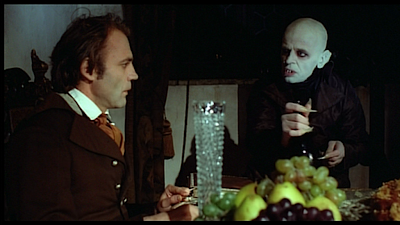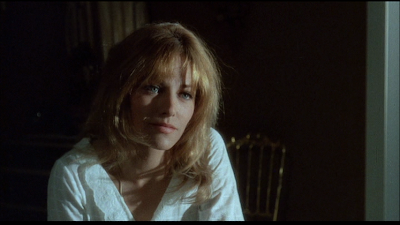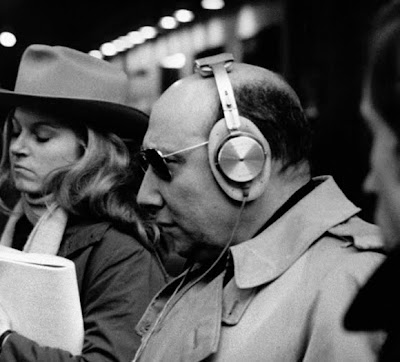
Nosferatu: Phantom of the Night
A film by Werner Herzog
Country: Germany
Year:1979
Runtime:107 min
German with English subtitles
23rd May 2010; 5.45pm
Perk’s Mini Theatre, Perks School

The general popularity of the Dracula story was significantly expanded with F. W. Murnau’s landmark German Expressionist film, Noferatu, eine Symphonie des Grauens (1922), which was an adaptation of Bram Stoker’s novel. Werner Herzog directed an explicit remake of Murnau's film, Nosferatu: Phantom der Nacht (Nosferatu the Vampyre, 1979). Murnau's film is a considerable improvement over Stoker's novel and that Herzog's film is an equally significant improvement over Murnau's classic.

Set aside for the moment the details of the Dracula story. They've lost their meaning. They've been run through a thousand vampire movies too many. Consider instead Count Dracula. He bears a terrible cross but he lives in a wonderful sphere. He comes backed by music of the masters and dresses in red and black, the colors De Sade found finally the most restful. Dracula's shame as he exchanges intimacies and elegant courtesies with you is that tonight or sometime soon he will need to drink your blood.

The crucial section, which conveys the existential sense of doom in Nosferatu, was about 24 minutes in Murnau’s version, but has been enhanced and expanded to 44 minutes in Herzog’s version. With many additional touches, Herzog creates a vision of a city fallen to a calamitous and hopeless dystopia. Van Helsing, the original voice of faith in human reason, is here reduced to pitiful fragility and impotence, utterly unable to deal with the out-of-control Renfield.

There is an added scene in which Dracula visits Lucy in her room and asks for her love. Lucy expresses firm confidence that, despite Dracula’s supernatural powers, the sheer power of her love for Jonathon, whom she loves greater than God, will restore him to her. It is only faith in love that makes us human.

Herzog completes the transformation of the Dracula story that Murnau initiated. It is now an existential horror story that captures our society's apocalyptic intimations of doom. In the end with Lucy and much of Wismar annihilated, Harker has become a vampire, himself, and sets out on horseback to wreak further death and the imposition of nothingness on a helpless and unsuspecting world. This is Herzog’s vision, masterfully brought to perhaps his ultimate expression. It also stands at the top of the scale in the history of horror films.
(Source:Internet)


Werner Herzog
“You should look straight at a film;
that's the only way to see one.
Film is not the art of scholars but of illiterates.”
One of the most influential filmmakers in New German Cinema and one of the most extreme personalities in film per se, larger-than-life Werner Herzog quickly gained recognition not only for creating some of the most fantastic narratives in the history of the medium, but for pushing himself and his crew to absurd and unprecedented lengths, again and again, in order to achieve the effects he demanded.
Werner Herzog (Werner Stipetic) was born Sept. 5, 1942 in Munich. He grew up on a farm in the Bavarian mountains. After his parents' divorce, Herzog and his mother moved to Munich where he attended High School (graduated in 1961). He travelled through Jugoslavia and Greece, worked in Manchester and - fact or fiction? - as a rodeo rider.

Werner Herzog and Klaus Kinski
In 1974, he walked from Munich to Paris to see the sick Lotte Eisner. He wrote a dairy about his pilgrimage entitled Vom Gehen im Eis (Walking on Ice) for which he received a literary award (Rausirer Literaturpreis) in 1979. He said that when he was 14 years old, he knew that he would be making films. His first short was completed in 1962 (Herakles) and one year later he founded his own production company.
Herzog studied history, literature and drama in Munich and Pittsburgh (Fulbright) but not for very long. He never attended a film school and had no formal film education. 1964 he won the Carl Mayer Prize for the screenplay that was to become his first feature film, Signs of Life (Lebenszeichen), which was financed by the Kuratorium Junger Deutscher Film (300.000DM) and won the Bundesfilmpreis for best first feature.
Among Herzog's most popular films, though not an immediate success, was Aguirre: The Wrath of God (1972) with Klaus Kinski, who also starred in Nosferatu (1979),Woyzeck (1979), Fitzcarraldo (1982), and Cobra Verde (1987). One of his biggest successes was Every Man for Himself and God Against All / The Mystery (Enigma) of Kaspar Hauser (1974), which won the Special Award in Cannes (1975) and several Federal Film Prizes (1975).
Herzog is famous for dealing with marginalized figures and for his choice of 'exotic' sets (Peru, Brazil, Australia). Herzog, the "visionary" of the NGC, insists that "film is not the art of scholars, but of illiterates."
In recent years, Herzog released a number of documentaries and directed various operas. His latest feature film is Invincible. He lives in Munich and Los Angeles.











